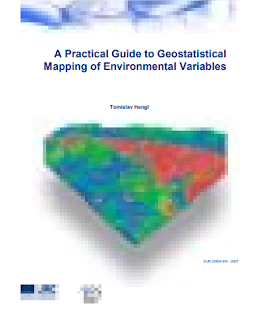The guide consists of four chapters. The first chapter is an introductory chapter to the practice of geostatistical mapping and gives an overview of the spatial prediction techniques. The second chapter zooms into regression-kriging and its characteristics, advantages and limitations.
 |
| A Practical Guide to Geostatistical Mapping of Environmental Variables |
The third chapter is completely dedicated to installation
and doing first steps in the software, and the last, fourth, chapter gives a step-by-step
guide through analysis and generation of final layouts by using a digital soil mapping
case study. After reading the first chapter, you should understand what the geostatistical mapping is; after reading the second chapter, you should know how to select the
right spatial prediction technique for your application; after reading the third chapter,
you should be able to install all packages used in the handbook and be aware of their
capabilities; and after reading the fourth chapter, you should know how to run geostatistical mapping, prepare final layouts and interpret the results of analysis for your own
case study.
This guide evolved as a lecturing material that has been used for a 5-day training
course called “Hands-on-geostatistics: Merging GIS and Spatial Statistics”. The objective of this course was to provide theoretical backgrounds and practical training on
the use of hybrid geostatistical/GIS tools for various applications ranging from spatial
prediction to sampling and error propagation. In addition, the leitmotive of the course
was to provide practical training in command-based software packages such as R. We
aimed at Master and PhD level students and post-doctoral researchers in various fields
of environmental and geo-sciences interested in spatial prediction and analysis of environmental variables. We have run this course already twice: at the Facolta di Agraria
in Naples (29.01-03.02.2007), and at JRC Ispra (03.06-07.06.2007). At both occasions,
the interest exceeded our expectations.
In fact, many course participants complained that their previous geostatistics courses focused too much on plain geostatistics (pure theoretical training) or were based on commercial packages (e.g. Isatis, ArcGIS). In our case, about 40% of the course has been dedicated to work in open-source software and practical aspects of data analysis: it included training on how to build and edit scripts in R and ILWIS, how to use commands in gstat and sp packages, how to export GIS layers to Google Earth and generate final layouts etc. This guide follows more or less the same structure, except it is probably more extensive and one would not be able to teach all these topics within five days.Another important motive to produce this handbook was to diminish frustrations a typical beginner has with geostatistical theory. Many users of geostatistics are confused with the amount of methods and with interpreting the results of some computation in a statistical software.
In fact, many course participants complained that their previous geostatistics courses focused too much on plain geostatistics (pure theoretical training) or were based on commercial packages (e.g. Isatis, ArcGIS). In our case, about 40% of the course has been dedicated to work in open-source software and practical aspects of data analysis: it included training on how to build and edit scripts in R and ILWIS, how to use commands in gstat and sp packages, how to export GIS layers to Google Earth and generate final layouts etc. This guide follows more or less the same structure, except it is probably more extensive and one would not be able to teach all these topics within five days.Another important motive to produce this handbook was to diminish frustrations a typical beginner has with geostatistical theory. Many users of geostatistics are confused with the amount of methods and with interpreting the results of some computation in a statistical software.
Download Link



No comments:
Post a Comment